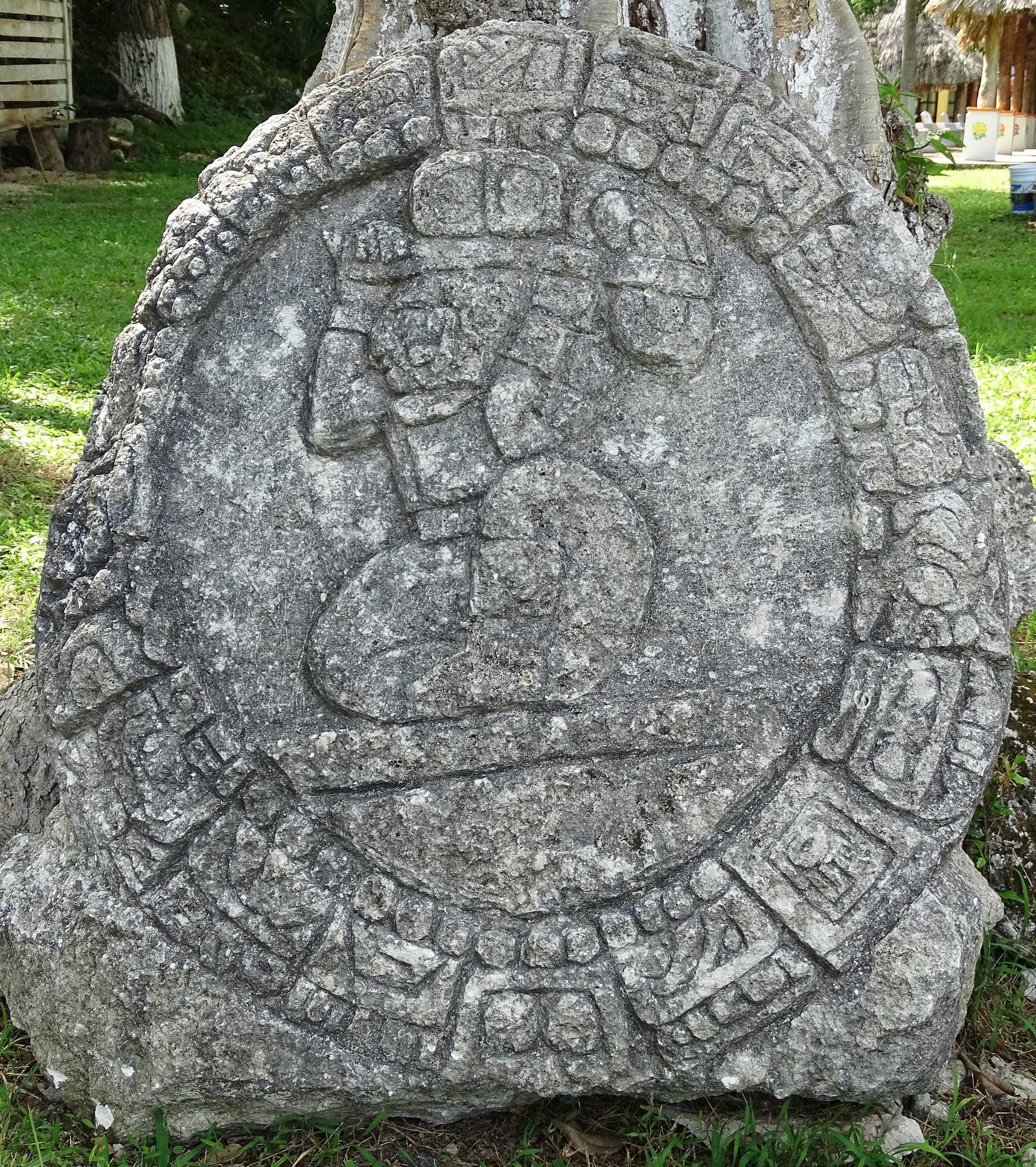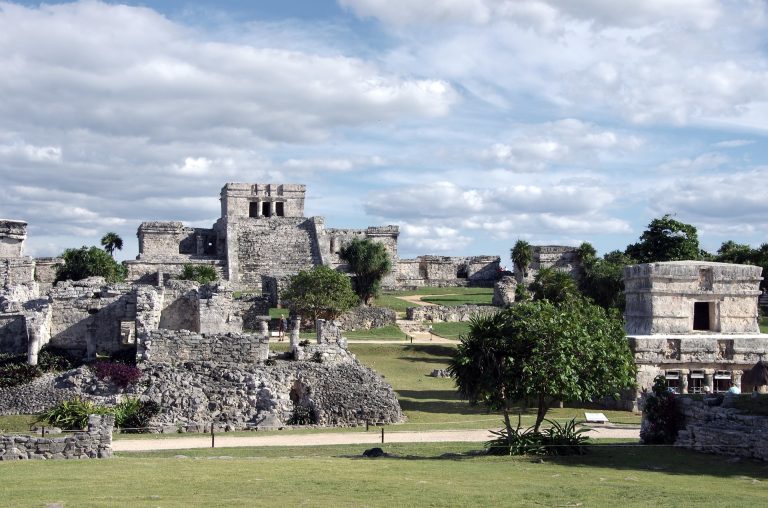The tropical rainforests of southern Mexico, Guatemala, Belize, and Honduras were home to the Maya for most of the first millennium AD. These people established several kingdoms and minor empires, constructed massive palaces, ball courts, and temples; they were advanced in agriculture and used a sophisticated hieroglyphic script; yet this advanced and prosperous civilization was short-lived. The Mayan collapse has remained a mystery for centuries.
Many theories have arisen over the cause of its collapse, with evidence now pointing to a prolonged and severe drought. Fortunately, the history of Mayan culture is relatively well-preserved. Multi-story buildings were constructed to mark important historical events. The colorful structures aligned with the sun and were highly visible from a distance, with enormous sculptures illustrating the rulers’ ruthlessness; and great stone slabs, or stelae, depicting kings with hieroglyphic texts recording their history and military victories.
A complex culture
Due to the prosperity of the Mayan agricultural systems, the civilization grew in size and number. At its peak, the Mayan population numbered in the millions, with an empire comprised of several city-states that were well-connected to one another. At the elite and royal levels, this connection manifested in the form of official visits, occasional overlordship, marriages, warfare, and general ideological affiliations.
Innovative agriculture
The Maya developed impressive technology for modifying the terrain. Since natural water supplies were lacking in the “Pook” [Puuc] region of the Yucatan Peninsula, they had to use their ingenuity to keep the population hydrated. Massive cistern systems, known as chultuns, were constructed, which could provide enough water to sustain their households for up to three months at a time in the absence of rain.
The Maya placed a high value on agriculture and the timely harvesting of crops. In Mayan mythology, the maize deity was severed during harvest and revived in spring. Most of the inhabitants were farmers who relied on the city priests for guidance on the ideal times to sow, harvest, and marry in rural regions.
Mayan trade and relations
Success
You are now signed up for our newsletter
Success
Check your email to complete sign up
The political links between Mayan city-states have been compared to those in Classical Greece and Renaissance Italy. Some towns had straight limestone causeways called sacbeob.
The Maya engaged in long-distance commerce with Teotihuacan, the Zapotec, and other communities in central and gulf-coast Mexico. They also traded with non-Mesoamerican cultures like the Tanos of the Caribbean. Archeologists have discovered Panamanian gold in Chichen Itza’s Sacred Cenote.
Building palaces, temples, and public works taxed Mayan labor. A king who won a battle might command more labor and demand tribute from conquered opponents, enhancing their economic power. The Maya bartered for items like obsidian, gold, jade, and feathers. They also exchanged food, salt, tools, and pottery.
Unlike the Aztecs or the Inca, the Maya never unified politically. City-states clashed regularly, and the Maya fought fiercely. Those captured were enslaved or sacrificed to the gods. In the fifth and sixth centuries A.D., a full-scale conflict broke out between neighboring city-states.
Astrological influences
The Maya were skilled in mathematics and astronomy. They could accurately predict cosmic events and incorporated astrological factors into their origin myth, sacred ceremonies, and calendars. Their Feasts were connected to the underworld and the universe, with the enormous Tree Of Life at the core of it all.
The Maya believed that their forefathers originated from a star cluster known as the Pleiades. The Popol Vuh, ancient Mayan scriptures that address creation, lineage, history, and cosmology, assert that many Mayan gods, including the great god-king Quetzalcoatl, a feathered serpent, returned to the stars. They claimed that Mayan ancestors would one day return.
The Maya kept multiple calendars, including the sacred tzolkin, a 260 day calendar derived from a careful permutation involving the numbers 1 through 13 rotating through 20-day glyphs. This was used to determine the dates for religious festivals. Their Long Count Calendar, which records mythological and historical events, runs a cycle of over 5000 solar years.

The mysterious Mayan collapse
Between 700 and 900 A.D., most Mayan towns and cities were abandoned and left to ruin. After just 150 years of dominance over the Yucatan Peninsula, the kingdom was brought to its knees. Some blame a major earthquake or storm, while others believe trading channels failed, or that rising city-states replaced the Maya peoples. It is also possible that the Maya peoples deforested large areas because their population and food demands surpassed the surrounding area’s resources, leading to a severe drought.
There are currently 88 ideas or variants of theories claiming to explain the Classic Maya Collapse. While there is no commonly recognized collapse hypothesis, drought is gaining support as the dominant theory.
Ancient lake reveals a clue
Researchers from the University of Cambridge and the University of Florida discovered important evidence buried deep in the silt of Lake Chichancanab that may help solve the mystery. Sediment cores that the scientists dredged out from the lake’s bottom provided a peek into what earlier ecosystems were like.
In the study, the scientists focused their attention on precipitated gypsum, a soft mineral that absorbs oxygen and hydrogen isotopes of water molecules into its crystalline structure. The samples revealed that the region around the lake had experienced severely prolonged dry conditions.
The researchers discovered that between the years 800 and 1,000, yearly rainfall in the Mayan lowlands declined by roughly half on average and by as much as seventy percent during periods of extreme dryness. This suggests that the rains in this area came to a virtual halt about the same time as the empire’s city-states were deserted and abandoned.
Why do civilizations fall?
It is hard not to see that we are presently confronting many of the issues that archeologists agree can contribute and lead to a civilizations’ decline; namely, uncontrolled population migrations, pandemic illnesses, collapsing governments leading to increased violence, disrupted trade, and climatic change.
History has repeatedly shown that although civilizations may achieve significant technical advances and preserve a large amount of knowledge, that does not make them immune to failure.
While certain elements are necessary for a civilization to survive, good cooperation and goodwill go a long way toward its continuation. One of the primary reasons that civilizations collapse is that the moral standards often degrade as wealth and convenience grow.
Traditional belief holds that when moral standards are high, and people act in accordance with heaven’s will, divine beings will protect and preserve their civilization; but when people abandon morality, and act out of selfishness and greed, indulging their every desire, disaster is imminent.















